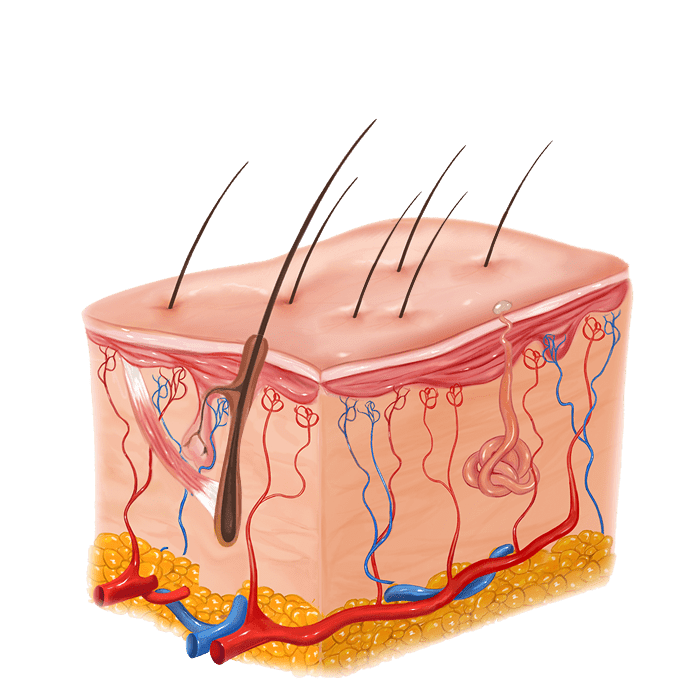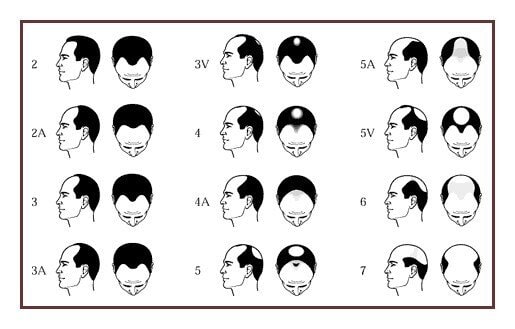Causes of Hair Loss in Men:
Treatment & Solutions
Men can start to experience hair loss as early as 16 years of age. Men under the age of 20 have a 5% chance of experiencing genetic hair loss, while those aged 20 to 30 have a 16% chance, and men aged 30 to 50 have a 53% chance of experiencing genetic hair loss. The good news is that TM Hair can customize a solution for any age or extent of hair loss.
Common Causes for Hair Loss and Baldness in Men
Hair loss and baldness in men can result from genetic or medical conditions. Discover the common causes and learn about the solutions that can help.
Androgenetic Alopecia
One of the common causes of hair loss in men is androgenetic alopecia, also known as male pattern baldness, caused by genetics. This condition progresses as testosterone is converted to dihydrotestosterone (DHT). DHT decreases blood flow to the hair follicle, causing the hair to become thinner until it becomes nonexistent. The signs of male pattern hair loss can present as a receding hairline or baldness on the top of the head, while keeping hair on the sides and back.
Holistic Solutions
Male pattern baldness treatments can be applied as soon as the first signs are noticed. These holistic approaches can minimize the progression of genetic alopecia and can include:
- A healthy diet and exercise
- Minimizing stress
- Adequate sleep
- A proper shampoo and conditioner hair care routine
Low-level laser therapy(LLLT)can also be considered asa potential treatment optiontohelp stabilize hair loss. This form of therapy was cleared by the FDA in 2015. It is a safe and effective treatment for stopping the progression of genetic alopeciaand promoting the regrowth of thinning hair, with no reported side effects.
Terminal Hair

Miniaturizing Hair

Miniaturized Hair

What can I do to stop my hair from getting worse?
Prevention:
Medications (Finasteride & Minoxidil)
Prescription medications, such as Propecia and Finasteride (a generic version), are available to combat genetic hair loss. They work by blocking the conversion of testosterone into DHT. The effectiveness of these medications stops the progression of hair loss in a majority of cases. The likelihood of experiencing unwanted side effects from Propecia or Finasteride is less than 5%. Minoxidil and Rogaine are topically applied and can be purchased without a prescription.
Nonsurgical Hair Systems for Men
These systems consist of a thin, breathable membrane with human hair injected into it one strand at a time. The membrane is applied to the scalp with a medical adhesive, allowing it to remain in place and be treated similarly to natural hair.
Surgical Hair Restoration (FUE & FUT)
Surgical hair transplants involve surgically harvesting hair follicles from the back of the head or the nape of the neck areas that still contain hair. The removed hair follicles are transplanted into the affected areas. When done by a credible surgeon, the hairs transplanted are unaffected by DHT and should grow and stay indefinitely.
Comparing Surgical vs. Non-Surgical Hair Restoration
Surgical Hair Transplant – This process is when “grafts” or hair follicles are surgically harvested from the back of the head/nap of neck area that are not affected by DHT. After removal, the grafts are transplanted in donor sites that were created in the hairline and bald areas on top. When surgical hair restoration done properly by a credible surgeon, the new hair follicles should grow and be permanent.
Non-surgical hair replacement – All men are candidates for this solution. These solutions are pain-free and can re-create any hairline or full head of hair. TM Hair offers non-surgical solutions for hair replacement.
Where Will You Be in 5 Years?

Other Secondary Causes of Hair Loss in Men:
Alopecia Areata
Certain medical conditions can also cause hair loss and baldness in men. For example, alopecia areata is a type of hair loss caused by an autoimmune disease. For those experiencing alopecia areata symptoms, medication solutions can include:
- Corticosteroid Injections: Injecting steroids into the affected areas can suppress inflammation and stimulate hair follicles.
- Topical Steroids: Creams or ointments can help manage inflammation.
- Minoxidil or Finasteride
Other minimally invasive or noninvasive treatments are available, such as Platelet-Rich Plasma (PRP) therapy, Low-Level Laser Therapy (LLLT), and Scalp Micropigmentation (SMP). PRP therapy helps regenerate hair growth by injecting platelets from the patient’s blood into the scalp.
Consult with a Professional for a Targeted Treatment Plan
For more information on how TM Hair can help with hair loss in men, check out our video on the Causes and Solutions for Hair Loss and How We Can Help. Once armed with the knowledge of possible hair loss solutions, there is nothing to lose by contacting us to schedule a free consultation and scalp analysis today!

